Field Medical Intervention: Gorilla Kariya Runga
By Gorilla Doctors Staff on Wednesday, October 14th, 2009 in Uncategorized.Last week I had my first experience treating a sick, wild mountain gorilla. Dr. Eddy had been following the case of a 3 year old gorilla from Humba group in DRC, who had a terrible respiratory infection. She felt so bad that she stopped eating, and trackers felt she was growing weak. Dr. Eddy and I planned to visit the group together, and were prepared to intervene, if necessary. My friend Molly Feltner, is a free lance photographer and reporter. She happened to be in town, and she joined us to document the day, which was wonderful because it allowed me and Dr. Eddy to concentrate on our patient while she took the photos.
Here is her account of our day:
“As the saying goes, “when it rains it pours.” Wednesday, September 30, was a three alarm fire for MGVP. The three countries where MGVP works – Rwanda, Congo, and Uganda – each had a sick or injured mountain gorilla that required a vet’s attention, a logistical challenge MGVP has not often faced.
Two potential interventions where planned a day earlier. Dr. Magdalena would stay in Rwanda to check up on a sick 8-day old baby belonging to Mukecuru of Pablo Group. For several days, trackers reported the infant to be crying incessantly. The Gorilla Doctors suspected either an injury or that the mother, an older female whose previous baby had died, was not producing milk for the baby.
Dr. Jan, Dr. Eddy, and myself, Molly Feltner, a freelance journalist, would go to Congo to treat Kariya Runga, a 3.5 year old female in Humba Group, who was observed to be very weak and suffering from cold-like symptoms. Dr. Jan and I left MGVP headquarters in Rwanda at 6 am so we could be at the border by the 7am opening time. Dr. Eddy met us and helped us bring the medical supplies across without drawing questions from the immigration officials. From Goma it was an hour drive to the Virunga National Park headquarters at Rumangabo and then another hour drive to the Bukima ranger station—plenty of time to discuss the options for Kariya Runga.
If she appeared improved Dr. Eddy would simply dart her with antibiotics. If she was worse, a full intervention would be required, a much more complicated process. First she would have to be darted with anesthesia and then Dr. Jan and Dr. Eddy would go to her to administer fluids and antibiotics and take samples for diagnosis back at the lab. The trackers would work together to keep away the other gorillas, most especially the protective ~200 kilo silverback, Humba. This would be Dr. Eddy’s fourth intervention, and Dr. Jan’s first. In 2006 Dr. Eddy treated two gorillas that had their hands caught in wire snares and later he treated a gorilla that survived the 2007 gorilla massacre but had suffered a serious laceration caused by a machete.
Along the road we saw many depressing signs that the illegal charcoal trade in the park was quite active and being supported by the Congo military. We passed by several flatbed trucks carrying thousands of kilos of charcoal, each guarded by armed soldiers, as well as countless overloaded wooden bicycles being pushed by weary villagers towards Goma. It is suspected that people within the charcoal industry were responsible for the gorilla slayings in 2007 and it is doubtless that charcoal is reason behind much of the deforestation and violence occurring in the park.
We finally reached Bukima around 9:30 am and met the rangers and trackers who would help us find the Humba group. Dr. Jan and I had prepared for a tough climb up the volcano, but the trek was easy. We spent 30 minutes walking through fields along the park’s border and then had an easy 20 minute walk through the forest to the Humba Group. We found the family resting near a small cave, totally unbothered by our presence. Kariya Runga was nearby napping with Humba, her attentive father, at her side. The mother, Gato, was nearby with her new son, a yet unnamed seven-month-old infant. Dr. Jan observed that all the gorillas, save Kariya Runga, appeared to be well, a hopeful sign that there was not a disease outbreak.
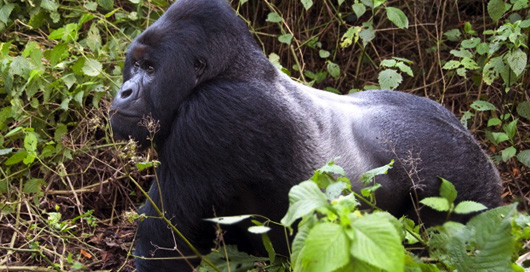
Humba keeping an eye on us.
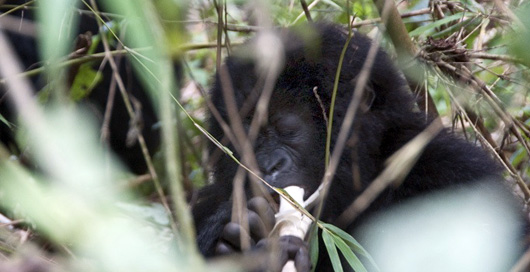
Kariya Runga eating bamboo with a snotty nose and puffy eyes.
At first Kariya Runga appeared very weak and the Gorilla Doctors suspected that a full intervention would be necessary. However, after 10 minutes the youngster got up and started walking around, covering a good distance in a short amount time, and was eating well. After further observation and discussion Dr. Jan and Dr. Eddy decided it would be best to dart Kariya Runga with antibiotics and then see whether she improved or not over the following days.
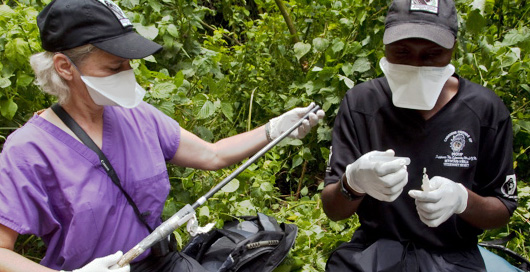
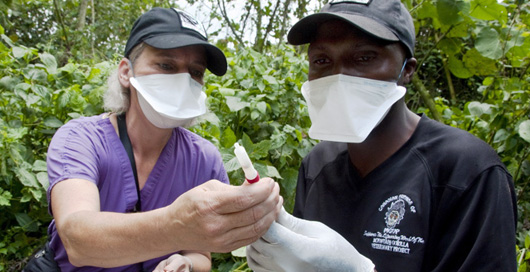
Dr. Jan and Dr. Eddy preparing to dart Kariya Runga.
The Gorilla Doctors prepared a dart containing 5 ml of Ceftriaxone, a broad spectrum antibiotic that can cure a range of bacterial infections. Dr. Jan assembled the dart gun while Dr. Eddy carefully measured the correct dose and injected into the dart. Leaving most of the group behind so as to not cause alarm in the gorillas, Dr. Eddy, Dr. Jan, myself, and a tracker went to find the sick gorilla. Darting a gorilla can be difficult, especially if the animal is hiding in dense foliage, but Dr. Eddy had no problem getting a clear shot of Kariya Runga. The gorilla didn’t make a peep when the dart hit her behind; she simply pulled it out and kept on walking.
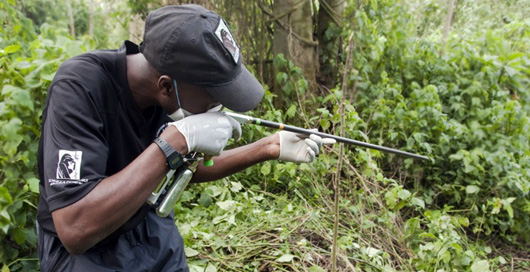
Dr. Eddy taking aim.
Dr. Jan picked up the discarded dart and saw that the medicine had been delivered. Success!
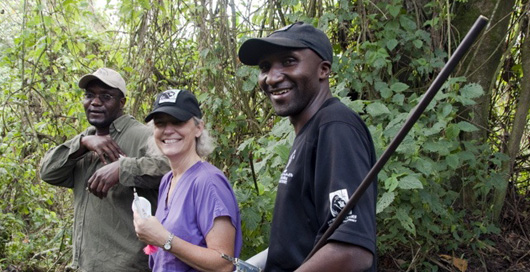
Successful darting!
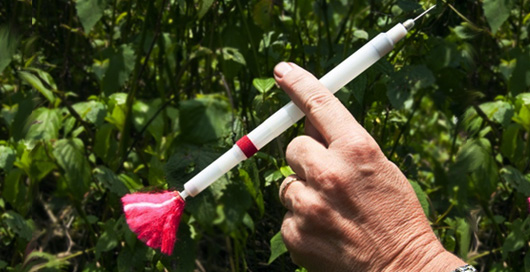
The gorilla group settled in a bamboo patch and we saw Kariya Runga eating happily, albeit with a snotty nose. She looked better than any of us had expected and we were hopeful the antibiotics would do the trick. Relieved, we watched the Humba group as they displayed their tree climbing skills. One by one the gorillas climbed a tree, and eventually massive Humba muscled his way up the branches. It was a display that would make tourists drool.

Humba climbing the tree!
On the way back Dr. Jan was called by Dr. Benard, the MGVP veterinarian in Uganda, who said that two silverbacks in Bwindi had been in a fight and sustained injuries. Dr. Bernard was sick so Dr. Jan called Dr. Jean-Felix in Rwanda and asked him to drive to Uganda to evaluate the silverbacks. Eventually he found that the injuries were not serious and no intervention was required.
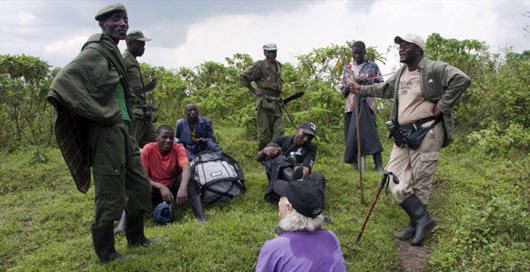
Back from the forest, mission accomplished.
Later Dr. Jan reached Dr Magda who had alarming news from Rwanda. She and the trackers had reached Pablo group and despite hours of searching they could not find Mukecuru or her baby. Several days later Mukecuru returned to her group but the baby was dead and she was very weak. Forty percent of infant gorillas die within the first year of life, so this baby’s death was not a surprise, but every gorilla death is a blow to the group and to the Gorilla Doctors. This week Mukecuru continues to carry the dead infant buttrackers report that she is getting stronger.
Kariya Runga, thankfully, is doing much better. Dr. Eddy and the Congolese trackers have kept a close watch on her and have seen her steadily improve.”
Help the Gorilla Doctors.


 Donate
Donate